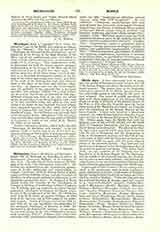

Micrologus, either a “synopsis” or a “short explanation”, and in the Middle Ages used as an equivalent for “Manual”. The best known of several is “Micrologus de ecclesiasticis observationibus”, an explanation of the liturgy of the Holy Sacrifice of the Mass, and of the ecclesiastical year; first edited at Paris, in 1510, and handed down in a number of manuscripts (P.L., CLI sqq.). This comprehensive work, of importance for both the history and the adequate understanding of the liturgy of the Mass and of the ecclesiastical year, is divided into three parts. The author treats first of the Mass (chap. i-xxiii) in relation to its historical development; second, of the liturgy of the ember days (chap. xxiv-xxix); and third, of the whole of the ecclesiastical year, with observations of the offices of the feasts and holidays (chap. xxx-lxii). In chapters xxiv-xxv the writer emphasizes the authority of the Apostolic See in liturgical questions, and mentions Gregory VII in such a manner as to show that he was an adherent of that pope, although Gregory was dead at the time the author wrote; he also refers to Anselm of Lucca in such a way as to infer Anselm’s being still alive at that time (chap. xvii), hence we may conclude the work to have been composed between May 23, 1085, date of the death of Gregory VII, and March, 1086, the death of Anselm of Lucca. No of Chartres was generally held to be the author of the “Micrologus”, but investigations of Dorn Morin and Dom Baumer point to Bernold of Constance, a monk of the abbey of St. Blasien (d. 1100), as the author.
Another well-known treatise, edited under the title “Micrologus de disciplina artis musicn”, is by the famous Guido of Arezzo, and is one of the most important writings of that teacher of ecclesiastical music (P.L., CXLI, 379 sqq., ed. Hermersdorff, Trier 1876).
J.P. KIRSCH

